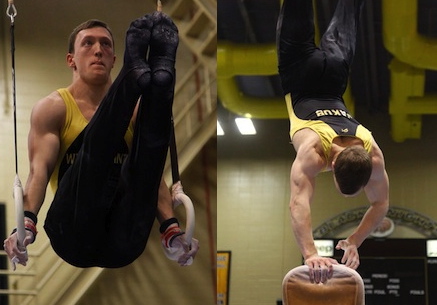 Intelligent Design
Intelligent Design
 Life Sciences
Life Sciences
Acrobatic Protein Stars in Two Gymnastic Events

Like a gymnast good at both pommel horse and rings, here’s a protein that folds into two shapes with two functions.
“We showed that RfaH refolds, which is a big enough deal already. You would think this is impossible. That’s what you’re told in school,” says Ohio State microbiologist Irina Artsimovitch in a news release from the university. She was speaking of a well-known transcription factor named RfaH, universally conserved throughout all life, that was found to unfold and refold into another form with a different function.
As a transcription factor, RfaH binds to DNA and the RNA polymerase enzyme that will transcribe a gene. With that function accomplished, something unexpected happens:
But the researchers observed that when RfaH binds to DNA and RNA polymerase, its two halves separate, with one remaining bound to the enzyme and another holding on with just a string of a few amino acids. And then it refolds into a completely different shape.
In its “alpha” form, the protein looks like two spirals. In its “beta” or barrel shape, it looks like spokes on a wheel. The discovery is being called remarkable and unprecedented:
Though the process happens in seconds, Artsimovitch likened the refolding to “having a knitted sweater that you rip out and then knit into a sweater with a different pattern.”
The beta shape allows RfaH to function as a translation factor. For messenger RNA transcripts lacking a clear binding sequence, RfaH steps in and binds to it and to the ribosome, allowing translation to begin. Artsimovitch commented on this design:
“RfaH can interact with the ribosome once it refolds. It’s a really smart way to do it. It’s a tiny protein, yet it can bind to both the RNA polymerase and the ribosome at the same time and link them together”….
“There is actually a big question here: How does RfaH know where to begin binding to the message to recruit the ribosome? We can tell that the ribosome knows where to start, but how it knows, we have no idea,” Artsimovitch said.
Is this a unique case of a refolding protein? The team at Ohio State expects more to be discovered:
The findings have significant implications for studies of gene expression control and protein structure. This remarkable ability to refold suggests that RfaH and similar proteins might be able to bind in ways and to other molecules that had never been considered. Scientists who engineer proteins might have an entirely new step to add to their models. And now that the first case of a complete alpha to beta structural change has been demonstrated, chances are good that researchers will find other proteins that can do the same thing.
The discovery about RfaH was published in the July 20 issue of Cell, which also included a highlight under the title “Cell Olympics: Get ready for the Games with our exclusive look behind the scenes at the cellular feats of strength, endurance, and skill that underlie athletic prowess.” In the case of RfaH, Olympic feats can be traced all the way to a protein.
Image credit: West Point Public Affairs/Flickr.
